By KATHLEEN NELSON
Dr. Emmett Roper started his journey to a career in internal medicine by pondering a simple question.
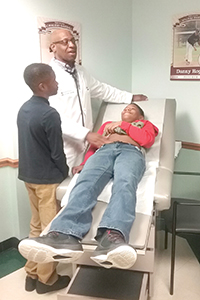
Dr. Emmett Roper shows boys in Ohio Hearts and Minds how to perform a checkup. Roper, an internist for Mercy Health, is among black professionals who are role models in the program that exposes black students to careers in math, science and health.
"The person who mentored me just asked what I was interested in," said Roper, who works for Mercy Health in Cincinnati. "That question could have come from anyone."
Dr. Kevin Cochran had an assortment of mentors who led him to his chosen profession as an interventional cardiologist.
"I learned lessons from high school sports, undergrad, medical school," Cochran said. "All along the way, there's been someone who knew more than me and was able to help, whether that was with academic or work performance. I think it's cut down on the number of mistakes I could have made."
Both are African American and know how lucky they were to have guidance. They're also keenly aware that many African-American boys lack a mentor. Through Mercy Health's partnership with a program called Ohio Hearts and Minds, they are filling that void.
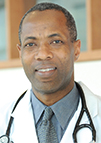
Cochran
Started in 2012 by Gary Favors, a public school special education teacher in Cincinnati, Hearts and Minds introduces African-American boys in fifth through 10th grade to black doctors and other black professionals. They learn about the education the professionals needed and the work they do. Participants have opportunities to explore careers in math, science and health. The group meets one or two weekends a month for science project help, career discussions and tutoring.
Role model
Ann Austin recognized that a mentor was the missing piece for her son, Aamir, 12. She works for the U.S. Postal Service, supporting her mother, daughter and Aamir, who has shown an interest in gaming and computers for about six years.
"I thought it would be good to have a male role model," she said. "I thought the program could give him a mind-set that I might not be able to give him. I wanted to show him that he could use that (computer) technology in many places, whether it's in a hospital or a university, and that a whole world could open up."
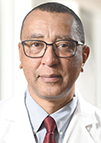
Galloway
The program aims to reverse trends cited in a report released in 2015 by the Schott Foundation for Public Education: "Black Lives Matter: The Schott 50 State Report on Public Education and Black Males." The report disclosed national graduation rates in 2012-13 of 59 percent for African-American males, 65 percent for Latino males and 80 percent for white males. The gap between African-American and white males has widened, increasing from 19 percentage points in 2009-10 to 21 percentage points in 2012-13.
"You've got to build a pipeline, especially with underrepresented populations," said Favors. "A lot of my students would be interested in science or medicine, but they don't have people who look like them to guide them."
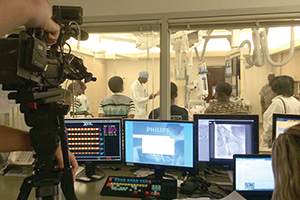
Children in the Ohio Hearts and Minds program listen as Dr. Kevin Cochran explains interventional cardiology in a procedure room at Mercy Health – Fairfield Hospital.
Sparking connections
Favors said he first thought about forming Hearts and Minds about seven years ago and shared it with Cochran after a church service about four years ago.
"He wanted to expose them to science and technology, and a hospital is a great place to do that," Cochran said. "I realized that maybe there were some people we could connect him with."
The two met with Yousuf Ahmad, former chief executive of Mercy Health–Cincinnati, and came up with the idea of a day in which students could visit Mercy Health and learn more about medical careers. For the past three years, the doctors have offered the day at least two or three times a school year, "and we would love for it to happen more often," Roper said.
The boys, usually a group of four to six, start by visiting Roper's office, learning to use some of the equipment of his daily duties: EKG, stethoscope, reading X-rays. They also visit the cardiology department, where Cochran explains his job and the high-tech equipment of his specialty.
"We let them know that someone had to build the equipment and maintain it and that there's a whole staff of people that make a hospital run," Cochran said. "We try to create a platform that exposes them to lots of different things that can trigger the thought, 'I could see myself doing that.'"
The right path
Favors noted that the program attracts about 10 participants a year. Its attendee numbers are low in part because of strict requirements that include:
- Mandatory attendance at all programs.
- Parent attendance at select sessions.
- A "B" average or better in all classes.
- Passing Ohio's annual academic standards test.
- Participation in a community service project.
Ann has attended every session with Aamir and says she has learned as much as her son.
"He likes the challenge and interaction with other boys as well as going to the different campuses and witnessing the things he would never see," she said. "I'm learning about things early and can plan, rather than find out too late, what he should be studying and how to prepare for college."
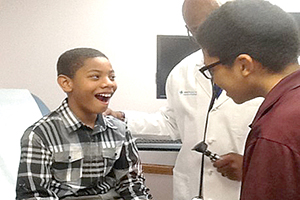
Boys in the Hearts and Minds program try on roles as patient and doctor.
By keeping the program small, Favors hopes to follow the students through high school graduation and reverse trends described in the Association of American Medical Colleges' report on medical education diversity, which found that 2.5 percent of medical school applicants were African-American men in 2011, a drop from 2.6 percent in 2002. That compares with 9 percent and 11 percent increases, respectively, in the share of Asian and Hispanic male applicants.
Roper and Cochran are eager to offer more: each has volunteered to serve on the Hearts and Minds board, Cochran attends and helps set up sessions in which he is not a speaker, and Roper has offered to open his home for study, mentoring and computer access.
"You never know what they'll get from the experience," Roper said. "Perhaps the act of offering makes an impact. Maybe they find someone else or something else through the experience with me or the other doctors."
Each acknowledges that they got involved to give back but have gotten more in return than they expected.
"I want to be one of those resources as much as I can. So many of the kids in Gary's program are missing that," Cochran said. "I enjoy interacting with the kids, especially if you're able to create an energy and see that spark develop in them."
Copyright © 2017 by the Catholic Health Association
of the United States
For reprint permission, contact Betty Crosby or call (314) 253-3490.